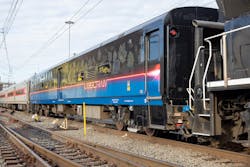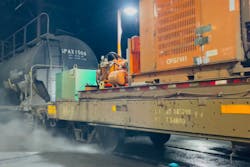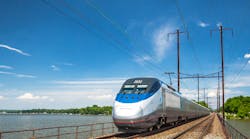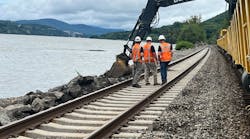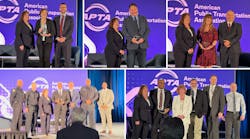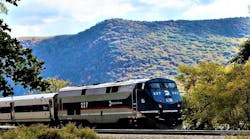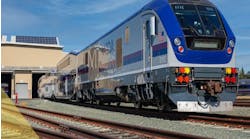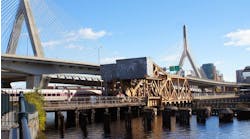East Coast Transit Agencies Perfecting Method of Dealing with Pectin on the Rails
On the East Coast of the U.S., fall can be the most beautiful time of year. As residents put away their summer gear and dig out their snow shovels for the winter season, leaves change colors and fall off the trees.
For transit agencies in the eastern portion of the U.S., the leaves falling off the trees can be a problem for their railways. Leaves have a slippery substance on them called pectin and, when crushed beneath the wheels of a passing train, said pectin can present a hazard to safety and operations by reducing friction between the wheels and rail. This condition can result in flat spots on wheels, higher maintenance costs, unsafe braking and even derailments.
Three different East Coast transit agencies -- Metropolitan Transportation Authority’s (MTA) Metro-North Railroad in New York, New Jersey Transit (NJ Transit) in New Jersey and Southeastern Pennsylvania Transportation Authority (SEPTA) in Philadelphia, Pa., have recently started using new equipment to clean the tracks of pectin to ensure trains continue operating safely and reliably.
Metro-North Railroad laser train
The MTA’s Metro-North Railroad uses its laser train to clean the tracks. The laser train was introduced by Long Island Rail Road in 2017 before Metro-North began using the train on a trial basis in 2022. During the pilot, Metro-North Railroad safely cleaned more than 12,000 miles of track with the laser train, which resulted in a 40 percent reduction in slip-slide events.
The train operates on the Hudson Line, the Harlem Line and the New Haven Line and can travel at speeds up to 60 mph. Two three-kilowatt lasers are mounted on each side of the train to put down an approximate 1.2-inch cleaning band.
Chad Scholes, MTA Metro-North’s Railroad’s executive director of continuous improvement, explains why the laser train is a better solution for cleaning the pectin off the railroad tracks as opposed to a regular power wash, which MTA Metro-North Railroad calls a waterworld.
“We’re able to use the laser train even past freezing conditions when we have to actually sit the waterworld down,” Scholes said. “Therefore, we're able to operate it over greater environmental conditions and we're able to cover a lot more ground with it and do the entire network in a single day, whereas with waterworld, we're only operating at about 12 mph.”
Metro-North Railroad usually starts using the laser train in mid-October. The authority uses the I Love New York website to track conditions of leaves throughout the state. Scholes notes the authority also has access back to 15 years of slippery condition data to determine when it’s time to start using the laser train.
“We're trying to get ahead of the conditions from actually building up on the rail,” Scholes explained. “We don't want to wait until the leaves actually start to fall. We want to start a little bit before then so that we can keep up with the level of leaf debris and pectin that comes down on top of the rail.”
Metro-North Railroad received the Rail Safety Gold Award in 2023 from the American Public Transportation Association for developing a laser train capable of operating 60 mph. In May, the MTA Board approved a contract to allow Metro-North Railroad to outfit a second train with lasers to help keep tracks clear.
NJ Transit AquaTrack
The AquaTrack system has been in use by NJ Transit since October 2003. It consists of two 250-horsepower diesel-engine units mounted on a flat car with an operator control cab. Two pressure-pump units dispense water up to 20,000 pounds-per-square-inch directly to the top of the rail.
The original AquaTrack operates primarily on the Morris & Essex Lines and Montclair-Boonton Line, washing the rails twice a day Monday through Friday. On weekends, the Pascack Valley and Main/Bergen County lines are typically covered. In 2016, NJ Transit unveiled its second AquaTrack unit, which allows the cleaning process to maintain a larger coverage area in helping to prevent delays caused by slippery rail.
“Each line has specific and or unique challenges due to the terrain and falling leaves during the fall season,” said Kyalo Mulumba, NJ Transit senior public information officer. “To effectively remove leaves and the oily residue left behind on the rail, the AquaTrack will operate through specific areas at a reduced or lesser than normal speed to be more effective and make two passes daily. The operating speed of the AquaTrack, the length of track, rail of the line and weather play a major role on the time taken to clear a track.”
Mulumba adds one pass per tour during the morning and night or through an area by the AquaTrack does significantly enhance traction between wheels and the rail resulting in a good travel experience and does limit delays by a significant amount.
SEPTA’s three trains
SEPTA utilizes three trains to combat slippery rail season. Each train consists of a locomotive, a tanker car filled with water that carries all the components of a pressure washer system and a cab car. The trains also feature two spinner nozzles on each side of the trucks of the flat car. The trains run six days a week, Sunday through Saturday overnight between 9 p.m. and 5 a.m. when service is not operating.
“The only lines we don't gel on are the Amtrak Northeast Corridor,” Rich Mann, assistant chief office for railroad operations at SEPTA, said. “We run out to Newark at Delaware and run down to Trenton, N.J., so we do not do anything on the Amtrak line. We do gel on the Harrisburg line, on the Keystone Line because that, for us, is one of our heavier slippery rail lines, just because of the amount of foliage that surrounds that line and it benefits Amtrak, too.”
In December, as the weather gets colder and SEPTA starts seeing more delays due to the slippery rails, the authority will use a gel mixture it lays down in front of the trains along with sand that helps prevent derailment of the trains. The tanker car is filled with 500 pounds of the gel.
“Our mechanics will listen to the engineer and he'll tell us when to turn the gel on and turn it off,” said Assistant COO Rail Equipment Engineering and Maintenance at SEPTA Dennis McAnulla, who oversees all regional rail and metro rail vehicle maintenance, as well as rail engineering. “Typically, that's five catenary structures prior to the station. When he's telling us to turn that gel on, he's also reducing his speed down to five mph.
“What a lot of people don't realize with slippery rails, it's not only making sure you can stop at a station, it's also getting out of the station, too,” Mann detailed. “A lot of times when that engineer goes to take power leaving the station, you can't get any traction effort on the wheels because there's slip-slide so you lose time there. You lose time leaving the station. You lose time coming in because you're breaking a little further away and you're breaking a little lighter application than you normally would so you can make that stop.”
Mann noted most delays are six to 10 minutes. Precipitation can exacerbate slippery rail conditions and in situations where heavy rain causes more slippage, delays could be up to 20 minutes.
While slippery rails have been an issue during the fall season for a long time, McAnulla explained the technology the trains have in them are similar to the ones he used when he first started in the industry more than three decades ago.
“I started my career in maintenance as a mechanic at Wayne Junction. In the mid-1990s, we built our first wash train. We had a Chevy Suburban, utility vehicle that was a hi-rail vehicle and we put a gel tub in the back of that. One of the other things that we did back then is we built a rail scrubber, which had six motors on it and it was a hi-rail vehicle that had to be towed behind a locomotive and still, today, that scrubber is used on the Norristown High Speed Line to clean [its] rails in slippery rail season,” McAnulla said.

Brandon Lewis | Associate Editor
Brandon Lewis is a recent graduate of Kent State University with a bachelor’s degree in journalism. Lewis is a former freelance editorial assistant at Vehicle Service Pros in Endeavor Business Media’s Vehicle Repair Group. Lewis brings his knowledge of web managing, copyediting and SEO practices to Mass Transit Magazine as an associate editor. He is also a co-host of the Infrastructure Technology Podcast.
